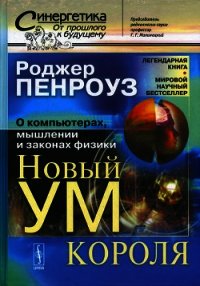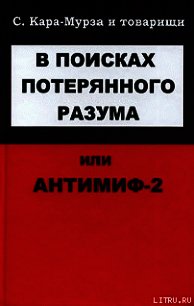Тени разума. В поисках науки о сознании - Пенроуз Роджер (книги онлайн полные версии бесплатно .TXT) 📗
[55] Clauser, J.F., Home, M.A., Shimony, A. (1978). Bell's theorem: experimental tests and implications. Rpts. on Prog, in Phys., 41, 1881-1927.
[56] Cohen, P. C. (1966). Set theory and the continuum hypothesis. Benjamin, Menlo Park, CA.
[57] Conrad, M. (1990). Molecular computing. В сб. Advances in computers (ed. M. C.Yovits), Vol. 31. Academic Press, London.
[58] Conrad, M. (1992). Molecular computing: the lock-key paradigm. Computer (November 1992), 11-20.
[59] Conrad, M. (1993). The fluctuon model of Force, Life, and computation: a constructive analysis. Appl. Math, and Сотр., 56, 203-259.
[60] Cooke, 1988.
[61] Costa de Beauregard, O. (1989). В сб. Bell's theorem, quantum theory, and conceptions of the universe (ed. M. Kafatos). Kluwer, Dordrecht.
[62] Craik, К. (1943). The nature of explanation. Cambridge University Press.
[63] Crick, F. (1994). The astonishing hypothesis. The scientific search for the soul. Charles Scribner's Sons, New York, and Maxwell Macmillan International.
[64] Crick, E, Koch, C. (1990). Towards a neurobiological theory of consciousness. Seminars in the Neurosciences, 2, 263-275.
[65] Crick, F., Koch, C. (1992). The problem of consciousness. Scientific American, 267, 110.
[66] Curl, R.F., Smalley, R.E. (1991). Fullerenes. Scientific American, 265, No. 4, 32-41.
[67] Cutland N.J. (1980). Computability. An introduction to recursive function theory. Cambridge University Press.
[68] Davenport, H. (1952). The higher arithmetic. Hutchinson's University Library.
[69] Davies, P. С W. (1974). The physics of time asymmetry. Surrey University Press, Belfast.
[70] Davies, P. C. W. (1984). Quantum mechanics. Routledge, London.
[71] Davis, M. (ed.) (1965). The undecidable — basic papers on undecidable propositions, unsolvable problems and computable functions. Raven Press, Hewlett, New York.
[72] Davis, M. (1978). What is a computation? В сб. Mathematics today; twelve informal essays (ed. L. A. Steen). Springer-Verlag, New York.
[73] Davis M. (1990). Is mathematical insight algorithmic? Behavioural and Brain Sciences, 13 (4), 659.
[74] Davis, M. (1993). How subtle is Godel's theorem? Behavioural and Brain Sciences, 16, 611-612.
[75] Davis, M., Hersch, R. (1975). Hilbert's tenth problem. Scientific American (Nov. 1973), 84.
[76] Davis, P. J., Hersch, R. (1982). The mathematical experience. Harvester Press.
[77] de Broglie, L. (1956). Tentative a"interpretation causale et nonlineaire de la mecanique ondulatoire. Gauthier-Villars, Paris.
[78] Deeke, L., Grotzinger, В., Kornhuber, H. H. (1976). Voluntary finger movements in man: cerebral potentials and theory. iol. Cybernetics, 23, 99.
[79] del Giudice, E., Doglia, S., Milani, M. (1983). Self-focusing and ponderomotive forces of coherent electric waves — a mechanism for cytoskeleton formation and dynamics. В сб. Coherent excitations in biological systems (ed. H. Frohlich, F. Kremer). Springer-Verlag, Berlin.
[80] Dennett, D. (1990). Betting your life on an algorithm. Behavioural and Brain Sciences, 13 (4), 660.
[81] Dennett, D. C. (1991). Consciousness explained. Little, Brown and Company.
[82] d'Espagnat, B. (1989). Conceptual foundations of quantum mechanics, 2nd edn. Addison-Wesley, Reading, Massachusetts.
[83] Deutsch, D. (1985). Quantum theory, the Church—Turing principle and the universal quantum computer. Proc. Roy. Soc. (Lond.), A400, 97-117.
[84] Deutsch, D. (1989). Quantum computational networks. Proc. Roy. Soc. (Lond.), A425, 73-90.
[85] Deutsch, D. (1991). Quantum mechanics near closed timelike lines. Phys. Rev., D44, 3197-3217.
[86] Deutsch, D. (1992). Quantum computation. Phys. World, 5, 57-61.
[87] Deutsch, D., Ekert, A. (1993). Quantum communication moves into the unknown. Phys. World, 6,22-23.
[88] Deutsch, D., Jozsa, R. (1992). Rapid solution of problems by quantum computation. Proc. R. Soc. Lond., A439, 553-558.
[89] Devlin, K. (1988). Mathematics: the New Golden Age. Penguin Books, London.
[90] DeWitt, В. S., Graham, R. D. (ed.) (1973). The many-worlds interpretation of quantum mechanics. Princeton University Press.
[91] Dicke, R.H. (1981). Interaction-free quantum measurements: a paradox? Am. J. Phys., 49, 925-930.
[92] Diosi, L. (1989). Models for universal reduction of macroscopic quantum fluctuations. Phys. Rev., A40, 1165-1174.
[93] Diosi, L. (1992). Quantum measurement and gravity for each other. В сб. Quantum chaos, quantum measurement; NATO AS1 Series С Math. Phys. Sci 357 (ed. P. Cvitanovic, I. C. Percival, A. Wirzba). Kluwer, Dordrecht.
[94] Dirac, P.A.M. (1947). The principles of quantum mechanics, 3rd edn. Oxford University Press.
[95] Dodd, A. (1991). Godel, Penrose, and the possibility of AI. Artificial Intelligence Review, 5.
[96] Donaldson, S.K. (1983). An application of gauge theory to four dimensional topology. J. Diff. Geom., 18, 279-315.
[97] Doyle, J. (1990). Perceptive questions about computation and cognition. Behavioural and Brain Sciences, 13 (4), 661.
[98] Dreyfus, H. L. (J 972). What computers can't do. Harper and Row, New York.
[99] Dummett, M. (1973). Frege: philosophy of language. Duckworth, London.
[100] Dustin, P. (1984). Microtubules, 2nd revised edn. Springer-Verlag, Berlin.
[101] Dryl, S. (1974). Behaviour and motor responses in Paramecium. В сб. Paramecium — a current survey (ed. W. J. Van Wagtendonk), 165-218. Elsevier, Amsterdam.
[102] Eccles, J. С (1973). The understanding of the brain. McGraw-Hill, New York.
[103] Eccles, J. C. (1989). Evolution of the brain: creation of the self. Routledge, London.
[104] Eccles, J. C. (1992). Evolution of consciousness. Proc. Natl. Acad. Sci., 89, 7320-7324.
[105] Eccles, J. C. (1994). How the self controls its brain. Springer-Verlag, Berlin.
[106] Eckert, R., Randall, D., Augustine, G. (1988). Animal physiology. Mechanisms and adaptations, Chapter 11. Freeman, New York.
[107] Eckhorn, R., Bauer, R., Jordan, W., Brosch, M., Kruse, W., Munk, M., Reitboeck, H.J. (1988). Coherent oscillations: a mechanism of feature linking in the visual cortex? Biol. Cybern., 60, 121-130.
[108] Edelman, G.M. (1976). Surface modulation and cell recognition on cell growth. Science, 192, 218-226.
[109] Edelman, G.M. (1987). Neural Darwinism, the theory of neuronal group selection. Basic Books, New York.
[110] Edelman, G.M. (1988). Topobiology, an introduction to molecular embryology. Basic Books, New York.
[111] Edelman, G.M. (1989). The remembered present. A biological theory of consciousness. Basic Books, New York.
[112] Edelman, G.M. (1992). Bright air, brilliant fire: on the matter of the mind. Allen Lane, The Penguin Press, London.
[113] Einstein, A., Podolsky, P., Rosen, N. (1935). Can quantum-mechanical description of physical reality be considered complete? В сб. Quantum theory and measurement (ed. J. A. Wheeler, W. H. Zurek). Princeton University Press, 1983. Первоначально в Phys. Rev., 47, 777-780.
[114] Elitzur, A. C, Vaidman, L. (1993). Quantum-mechanical interaction-free measurements. Found, of Phys., 23, 987-997.
115] Elkies, Noam G. (1988). On A4 + B4 + C4 = D4. Maths, of Computation, 51, (No. 184), 825-835.
[116] Everett, H. (1957). "Relative State"formulation of quantum mechanics. В сб. Quantum theory and measurement (ed. J. A. Wheeler, W H. Zurek). Princeton University Press, 1983; первоначально в Rev. of Modern Physics, 29, 454-462.
[117] Feferman, S. (1988). Turing in the Land of O(z). В сб. The universal Turing machine: a half-century survey (ed. R. Herken). Kammererand Unverzagt, Hamburg.
[118] Feynman, R. P. (1948). Space-time approach to non-relativistic quantum mechanics. Revs. Mod. Phys., 20, 367-387.




